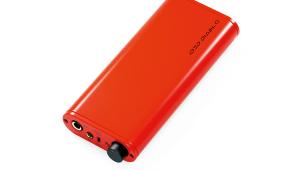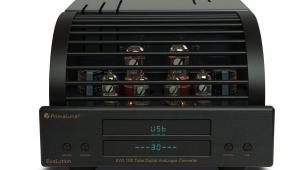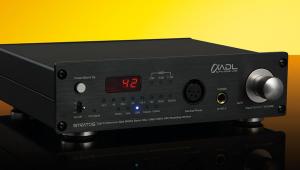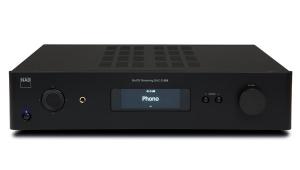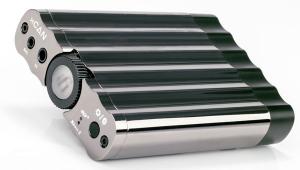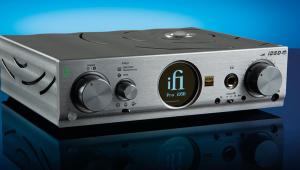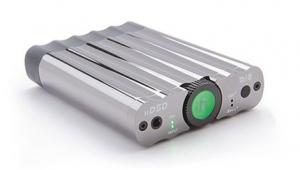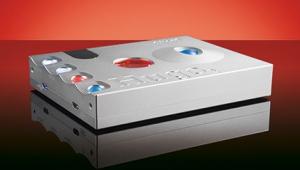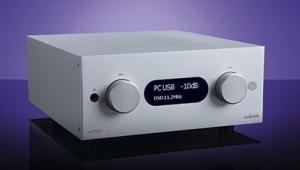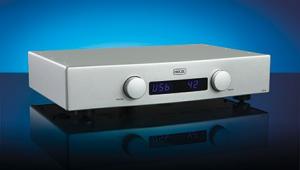Moon 300D- £1,350

here’s seldom much about Moon products that stands out a mile externally – which is not to deny them their smart and individual appearance. This particular member of the team has a largely typical specification, with two coaxial and one optical S/PDIF inputs and a USB socket, while analogue output is available both balanced and unbalanced.
Differences are more apparent inside the unit, where Moon has carefully separated analogue and digital parts of the equation. A digital circuit board, largely populated with surface-mounted components, receives the digital input, applies digital filtering and converts it to analogue, forwarding the output to an analogue board beneath. Here, components are all through-hole parts, remarkably few of them for a balanced-output circuit, with passive components evidently having been carefully selected for their specific application. The power supply is unusually generous too, with a large bank of smoothing capacitors.
Most of the integrated circuits that look after functions like digital input reception and D-A conversion are familiar parts, including the USB input chip, which limits operation to 48kHz. A footnote about this on Moon’s website hints that the company doesn’t much rate USB as a digital audio interface and suggests that the serious computer audiophile should use an aftermarket soundcard with S/PDIF output, a perfectly valid point.
Sound qualityIt wasn’t quite plain sailing for the 300D as far as our blind-listening panel was concerned: the odd note of criticism sneaked in, but the general tenor of comments was once again favourable. They were in agreement that treble is a little more present than bass – we’re choosing words carefully here because different listeners expressed that in different ways. One found the treble clearer than most, well defined and more precise than the bass. Another thought the bass was fine but found the treble on the bright side, even (in one track) ‘splashy’. This kind of difference of opinion is not uncommon in a case like this of subtle tonal imbalance and merely illustrates why no one product can provide all the answers.
The trouble is, though, that even in a blind test like this such things can colour a listener’s judgement. It’s no surprise that the listener who disliked the treble found fault also with detail and imaging, but the others were much more complimentary about these aspects, especially detail. It’s the kind of detail which doesn’t rip a piece apart into its constituent strands, but allows the listener to hear what’s going on at the top, in the middle and into the bass. The deepest bass is, perhaps, a little general here, with good extension but slightly less precision than some can muster.
Dynamics were well liked too. Our large-scale orchestral track benefitted particularly from this, with quiet passages having a degree of definition and solidity to them that’s not often heard. It’s easy to overlook low-level performance of audio equipment, or take it for granted, but the 300D really does achieve quite an unusual level of performance with both detail and imaging consistent from loud to soft and back.
With pace, rhythm and timing also good, though never over-emphasised, it’s an easy DAC to like.
LIKE: Good definition under all conditions; good timing; extended treble
DISLIKE: Can sometimes seem a little too bright
WE SAY: The 300D is also a low-stress performer with even-handed abilities
DETAILS
Origin: Canada
Weight: 3kg
Dimensions: (WxHxD) 190x85x280mm
Features:
• Digital inputs: two electrical S/PDIF (phono), one TOSLINK, one USB
• Analogue outputs: one balanced (XLR), one unbalanced (phono), fixed level
• Maximum sample rate: 192kHz (USB 48kHz)
Distributor: Renaissance Audio
Telephone: 0131 355 3922
Website: simaudio.com
 |
Inside this month's issue:
Q Acoustics 3020c standmount loudspeakers, Perlisten R10s active subwoofer, Quad 33 and 303 pre/power amps, Acoustic Solid Vintage Full Exclusive turntable, newcomer Fell Audio Fell Amp and Fell Disc and lots, lots more...
|



